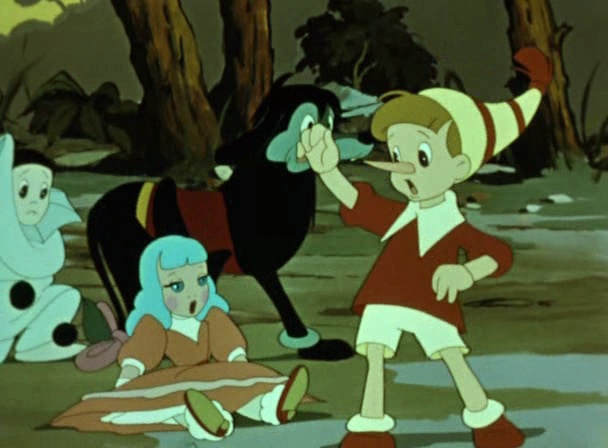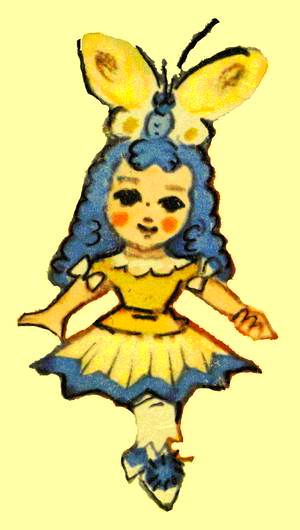|
The basic images of fairy tales |
||||||||
|
It is interesting to consider how uncharacteristic images for the Italian fairy tale appeared. Neither in the Italian origin nor in Berlin "alteration and processing" there is no Pero. It is purely TolstoyÆs creation and consequently an image Pero deserves to get accustomed more steadfastly to it. Distinct from an original plan the retelling plan is simply not clear out of the system of deviations and an image Pero in this system and the subject movements connected with it are very appreciable and considerable. Kollodi doesn`t have Pero but there is a Harlequin: he recognizes Pinokkio among the public during the performance and Pinokkio saves his doll life. Here the role of the Harlequin in the Italian fairy tale comes to an end and Kollodi does not mention him anymore. Here the Russian author grasps this unique mention and pulls out on a scene the natural partner of the Harlequin - Pero because the mask "the successful lover" (Harlequin) is not necessary to Tolstoy, he needs - "the deceived husband" (Pero). To call out Pero to a scene there is no other function of the Harlequin in Russian fairy tale: Buratino is recognized by all dolls, the scene of the rescue of Harlequin is omitted, in other scenes it is not occupied.
included at once and resolutely, gamegoes simultaneously on the text - traditional dialogue of two traditional characters of the Italian folktheatre and on implied sense - satirical, secret, full caustichints: "Behind the cardboard tree there was a small little manin a long white shirt with long sleeves. His face was sprinkled by powder, white, as a tooth-powder. He bowed to the most respectable public and told sadly: - Hello, my name is Pero... Now we will play for you a comedy under the name: "The Girl with blue hair, or Thirty three clips". I will be beaten by a stick, I will be given slaps in the face and clips. It is a very ridiculous comedy... From behind the other cardboard tree all checkered as a chessboard person jumped out. He bowed to the most respectable public: - Hello, I am a Harlequin! After that he turned to Pero and released to him two slaps in the face which were so sonorous that powder fell down from cheeks. A. Tolstoy enters Harlequin with those words "other person jumped out ". But there was no" first person, there was a "little man"- Pero is humiliated earlier, than he was given a name by that "little man" . Pero loves the girl with blue hair. The harlequin laughs at him because there aren`t girls with blue hair! (The motive of exclusiveness of Pero`s bride) - and beats him again. Malvina is a creation of the Russian writer and she is necessary, first of all, for selfless love of Pero. - one of the main differences of "Adventures of Buratino" from "The adventures of Pinokkio"
It is characteristic also that poet-lyric Pero (Block?) in a fairy tale is run down not only by Buratino but also the story- teller. For example: "Pero at the sight of Malvina started to mutter words - they were so incoherent and silly that we do not mark them here". Malvina. As M.S.Petrovsky noticed, her name is "a professional pseudonym of the maiden of easy behaviour". We learn about it that she ran away from theatre of Karabas Barabas because she was "couldn`t stand rough tricks of the owner". How did she live in a lonely small house in wood? It appears that "animals supplied her with all necessaries for a life": "the mole brought nutritious roots", "mice broughtsugar and sausage slices", "a hawk - fried game" "magpies stole chocolates in silvery pieces of paper at the market for her". Artemon washes her clothes: she conducts such parasitic way of life (and it`s interesting if it confuses her) abusing the kind relation to outside associates or she somehow makes her living. Naming the beautiful doll Malvina, Tolstoy relied on an old tradition, well-known to him , the expert on Russian XVIII-th century. The name of Malvina got to Russia with the poems of Scottish bard Ossian. These works were shown to the world in the end of a XVIII-th century by the English writer James MacPherson, these works were grandiose mystification. The name of Malvina is a name of a companion of aged Ossian and the girlfriend of his lost son Oscar ;this name got huge literary popularity and became the most attractive sign of a romantic beloved. The circle of reading of Tatyana Larina, for example, included the multivolume novel of French writer ,Maria Kotten, "Malvina". The name of Malvina entered into verses of young Zhukovsky and in young Pushkin's verses too, and in tens other poems. Then this name got into a romance and became a steady sign of romance`s heroine. At the beginning of our century the name of Malvina fell to the bottoms and was reflected in the literature of that epoch (for example, in A.Kuprin's "Duel" and in A.Remizov's story of "Malvina" from his book "city Noise") as a professional pseudonym of the maiden of easy behaviour. In what aura of meanings the name of Malvina enters into Tolstoy's fairy tale.
Kollodi has a girl with blue hair, she is a kind fairy in the Italian fairy tale. Unlike Kollodi`s girl the girl of Tolstoi with blue hair is not magic but household, satirically shined character. Pinokkio does not get to school and, hence, remains illiterate, nevertheless in one of following scenes he reads an inscription on a tomb of the magician with tears in the face . Perhaps, Tolstoy noticed this ridiculous discrepancy and thought up a scene of training of the hero to the reading and writing when alteration of "Pinokkio" in "Buratino" had begun? Anyway, but pedagogical temperament, passion to give lessons under any circumstances, purely teacher's pedantry, - steels defining lfeaturesof an image of Malvina.
Like the axem pupil copying the tutor, Malvina speaks the slang of governesses. Her speech is stylised under a bad translation from French: "Buratino, my friend, do you repent, at last?" Distracted lines and conditional values of Malvina obviously lose from the nearest neighbourhood with everyday resource and ingenuous judiciousness of Buratino. There is a check of characters on viability, and it becomes clear: viability - the greatest and all solving value in Tolstoy's artistic thinking. The particular interest represents an image of a street proletarian Karlo. Apparently, the concrete prototype at this image is not present. Maybe,it is a collective symbol of that class which raised Gorkyi was uplifted on a pedestal. A class once again deceived. And here there is a poor daddy Karlo in a wind poor who had nothing to lose except the chains, listens the same melody, the end of which is its beginning - in the same way as the end of "the Italian fairy tale"of Gorky returns all to the beginning.. The names of fantastic heroes participate in the creation of images. We already know that Buratino is the patrimonial name which has become the own name of a puppet, Pero who is the partner of the Harlequin in the Italian national comedy, Duremar is the simpleton whose name is said in a foreign manner, the name of the cat Basilio is pronounced in a
similar manner from the name of
the cat VasÆka. The name of Karabas Barabas is comprehended more difficult. The similar character of a fairy tale of Kollodi bears the name of Mandzhofoko that means " the fire-eater" . "Barabas" is conformably to Italian words with the meaning the villain, the swindler ("barabba") or a beard ("barba") - both that and another quite corresponds to an image. Puppet heroes of a fairy tale are allocated by the characters which are not too difficult (difficult would contradict genre laws) but expressed extremely intensively. "Human" character of daddy Karlo appears more faintly because sample traits of the theatrical role (something like "the noble father")are looked through in his character. Doctor of puppet sciences and the seller of bloodsuckers are more successful. In Karabas some miracle incorporated in a single image of line poster bourgeois and the fantastic malicious wizard. His friend Duremar - soul whose trade directs horror of loathing even at Karabas, - a pettiness which is on sale for a supper, the informer and the traitor. He throws the patron as soon as good luck leaves Karabas and changes the owner with readiness - he goes to winners to apply for a service. Tolstoy delicately holds back whether winners accept of service of the recent seller of bloodsuckers. All the names in a fairy tale ½play" but everyone in his ownway. Only a delicate hint on Russian senses of foreign names which are hidden draws system. This system connects names of characterswith a fairy tale plan, enters names into a circle of ideological problems of the work opposing native to foreign. |


